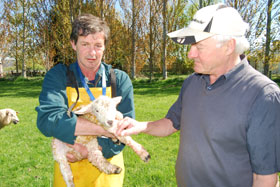
 Peter Smith and Dr Peter Hurst
Peter Smith and Dr Peter Hurst
A 27-year working relationship has brought the best of sheep and human research capabilities together and laid the foundation for a developing area of study.
Using sheep as a model for Polycystic Ovarian Syndrome (PCOS), Anatomy Senior Lecturer Dr Peter Hurst and AgResearch's Peter Smith are hoping to answer some fundamental questions about a condition that affects 10% of women and is a leading cause of infertility.
Although several treatments are available, all are aimed at keeping symptoms under control. None are able to cure or prevent PCOS as there is little understanding of the key trigger that causes it. The theory is that the cause lies in the earliest stages of life.
To Hurst and Smith, their different research backgrounds are mutually beneficial. “AgResearch knows a lot about ovaries, from a histology and microscope point of view, and the university has the human ovary knowledge and contacts with the hospital that allow us to have clinical input,” says Peter Smith.
And perspectives also help to encourage some good-natured competition. “We have many friendly disagreements about whether the condition is driven by the brain or the ovary. Once day we'll settle it!”
In fact both functions have an important role to play, and the question is how they operate together. This is the focus of the current trial, says Hurst. “The perturbation that leads to the condition may come from the hypothalamus, but we want to look at a molecular level at what's going on in the ovary.”
He says that access to Invermay facilities has been the key, where a flock of more than 100 sheep is available to work with and there is a strong focus on animal welfare. Ewes treated with testosterone during the gestation period are being compared to an untreated control flock, and the female lambs of both groups of ewes are being examined for PCOS. Treatments of this nature can be undertaken without causing the animal distress, and health and behaviour are constantly monitored.
Hurst has had connections with Invermay scientists for many years, and had kept in touch with Smith after meeting at a conference in the 1980s. A friendship and shared sense of humour turned into a research partnership when Smith made the decision to study towards a Masters, and Hurst was the obvious choice for a supervisor.
Despite this history, the more recent establishment of the Centre for Reproduction and Genomics has provided a common facility and funding, helping to consolidate a lot of relationships and create new ones, says Hurst.
Although undertaking the same research would still have been possible, says Smith, the Centre provides a way to keep a team of experts working closely together and this has attracted a lot of interest. The results of past investigations and the current trial have sparked further possibilities, including his own MSc topic. Peter's thesis focuses on the rete ovarii, a small and little-understood structure located within the ovary. It was previously thought to be vestigial, until clear changes were observed in 8 year old animals during and after hormone treatment. University of Otago PhD student Craig Preston is investigating the role of anti-Mullerian hormone in the sheep ovary, and the role this could play in PCOS. The university's Dr Caroline Larsen is using samples from the Invermay test flock to look at the hormone levels as a cause of post-partum anxiety.
The wider collaborative project between Hurst and Smith is funded by the Anatomy Department, with assistance from the Centre for Reproduction and Genomics.